| Rossini The Barber of Seville
Lucerne Opera 16 November 2005
Produktionsteam: John Axelrod (Musikalische Leitung), Claes Fellbom (Inszenierung), Werner Hutterli (Bühne), Dr. Christian Kipper (Dramaturgie) 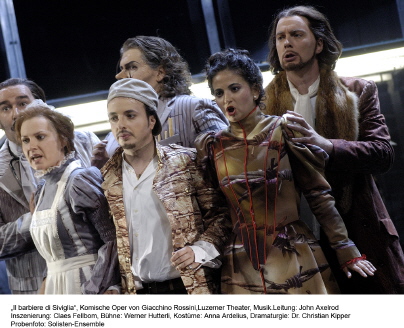
Teodora Gheorghiu, Caroline Vitale, Davide Cicchetti, Howard Quilla Croft, Gregor Dalal, Daniel Johannsen, Auke Kempkes, Boris Petronje
Luzerner Sinfonieorchester, Chor und Extrachor des Luzerner Theaters
After an abortive attempt by a rich nobleman's factotum and a motley crew of hired serenaders to lure to her window a girl his master has fancied, The Barber of Seville himself appears to save the day. Wreathed in polythene, from which he extracts himself not without difficulty, Figaro emerges to sing his famous aria, wearing defensive sunglasses and claiming to organise the whole town's business between appointments to cut and shave. Opera in Lucerne makes you think.
Everywhere a perennial favourite, one of the most often performed of all operas, Il Barbiere di Siviglia lends itself to an infinite variety of interpretations. In recent months we have enjoyed it in Raymond Gubbay's ill-fated Savoy experiment in London, a cut-price endeavour generally maligned (but not by us); on DVD a classic production with Bartoli, and last week a hugely inventive and anarchic version by Dario Fo, with Jennifer Larmore as an authorative Rossinian mezzo heroine; tremendous fun.
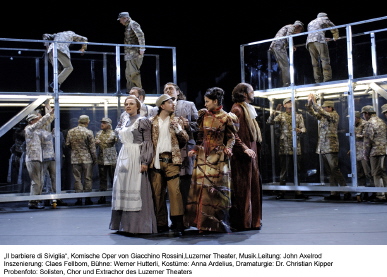 Lucerne Opera has never let us down, and having seen their Stallerhof, Der Kaiser von Atlantis and The Rake's Progress we now always expect something special. Lucerne Opera has never let us down, and having seen their Stallerhof, Der Kaiser von Atlantis and The Rake's Progress we now always expect something special.
Their house-style is to economise on sets (here two light, mobile metal industrial constructions of steps and perspex walls to signify Rosina's imprisonment) and concentrate on focused acting, costume, movement and lighting. Claes Fellbom's Barber is both as thoughtful and as funny as any you'll come across, and at first bewildering too.
 The chorus and the alert and responsive Lucerne Symphony Orchestra were under the musical direction of their American chief conductor, John Axelrod, and supported a performance of international calibre, albeit with names new to us. The chorus and the alert and responsive Lucerne Symphony Orchestra were under the musical direction of their American chief conductor, John Axelrod, and supported a performance of international calibre, albeit with names new to us.
The cast was strong, though unfortunately the Barber himself, British baritone Howard Quilla Croft, seemed to be having an off night*** and disappointed as the lynchpin of the plot and the most complex and enigmatic of the characters. Charmless (deliberately so?) and out of voice, his intonation and synchrony with the orchestra both suffered in comparison with Rossini's well characterised eccentrics who were his playthings and source of income.
But this is a prequel to Figaro's own Marriage by Mozart. By the time of the second play in Beaumarchais's trilogy, Figaro has settled for permanent employment in aristocratic service, and abandoned his multifarious ways of making a living (but not his scheming propensities) for full time service to the philandering Count Almaviva, who by now has seduced and married the unfortunate young, inexperienced Rosina.
Although Rossini's heroines are normally mezzos, Fellborn and Axelrod purposely cast a very young singer in a lesser known earlier version for soprano*, which Axelrod believes gives a greater chance to develop Rosina's character within the span of the opera from a guileless young girl into a 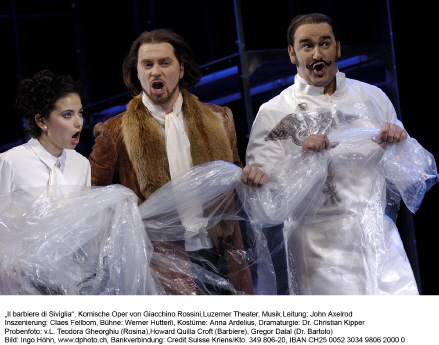 self-sufficient young woman ready to fend for herself. So at Lucerne one can plausibly envisage the charming young soprano Teodora Gheorghi growing (vocally too) into Mozart's sad, worldly wise Countess (also a soprano). self-sufficient young woman ready to fend for herself. So at Lucerne one can plausibly envisage the charming young soprano Teodora Gheorghi growing (vocally too) into Mozart's sad, worldly wise Countess (also a soprano).
We all know that in escaping Dr Bartolo's unfeeling possessiveness, Rosina will but have exchanged one form of imprisonment for another; unloved matrimony. And that in Mozart's great social comedy, the rootless Figaro will discover his own identity as the long lost son of the bumbling, egocentric Bartolo and his put-upon servant Marcellina, whose affection for her difficult boss is hinted towards in Claes Fellbom's Barber. Might the Lucerne team, with their resident dramaturge Christian Kipper, seek some fresh insights into The Marriage of Figaro too in connection with the Mozart year, 2006?
Bartolo was depicted by Gregor Dalal as a medical man, not too old to plausibly think of himself as an imminent bridegroom, and with thoughts only for himself. He begins Act 2 working with speculum and protective clothing, and we see him perpetrate an unspeakably macabre extraction of who knows what, before absent mindedly sending off another patient with a saw to amputate his own arm!
For me, the show was practically stolen by the director's expansion of the (usually) small part of his housekeeper and long ago lover, Marcellina/Berta, allotted by Rossini but one aria to express her frustration with her irascible boss. Caroline Vitale's solicitous caring for Don Bartolo in Act 1, was followed by the most musicianly account of that aria; a voice and a name to remember. By the end it has become clear that she will soon be the Mrs Bartolo after the Doctor was tricked out of the intended forced marriage to his young 'ward' Rosina (what of her history?).
The characters in Il Barbiere di Siviglia are each defined by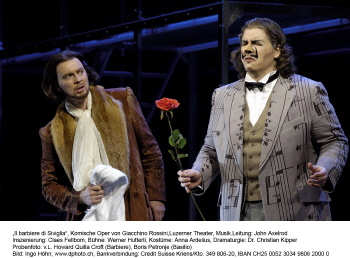 Anna Ardelius's witty, metaphorical costumes. Teodora Gheorghi's outer garment is patterned with barbed wire, but beneath it, to express Rosina's yearning for freedom, is a sexy, bright red flouncy dress. Anna Ardelius's witty, metaphorical costumes. Teodora Gheorghi's outer garment is patterned with barbed wire, but beneath it, to express Rosina's yearning for freedom, is a sexy, bright red flouncy dress.
As Don Basilio, Boris Petronje advertises his trade wearing a suit decorated with musical motifs, but his driving penchant is to wallow in slander and intrigue for whoever will pay him. He is eventually hoist on his own petard after being replaced by the impostor Count, and meekly allows himself to be befuddled, wrapped in polythene (c.f. Figaro's first entrance) and driven out to go straight back to a purported sick bed.
David Cicchetti, as Rossini's shallow young Count, captivated by this young girl who must be his, brought a delightfully fresh and flexible light tenor to his manifestations in disguise. Under Figaro's tutelage he gains access to the house first as a 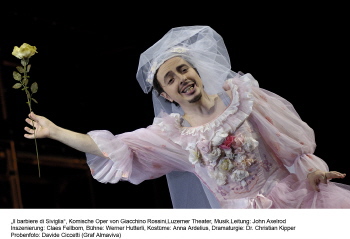 drunken soldier (his uniform purchased by Figaro before our eyes from an old soldier, who hobbles away in his underclothes!) and then in flouncy drag as deputy singing teacher for the supposedly indisposed Basilio. drunken soldier (his uniform purchased by Figaro before our eyes from an old soldier, who hobbles away in his underclothes!) and then in flouncy drag as deputy singing teacher for the supposedly indisposed Basilio.
This Barber, like The Rake being shown in parallel - caught again next night - needs to be seen twice to pick up on all its subtleties, some of them broached in the fully illustrated programme books, with revealing interviews between dramaturge Christian Kipper and the stage and musical directors. John Axelrod explains how attention to detail in the score brings out aspects of the characters and their emotions usually ignored or jettisoned in favour of sheer fun. Lucerne Opera's Barber goes far beyond frothy light entertainment.
I appreciate that lacking star names and elaborate staging, neither of these Lucerne Opera productions would appear likely to be commercially viable on DVD, given all the competition. But the opportunities should not be lost to make high quality video records of them both, using two or three digital cameras. At the least they would provide magnificent material for media studies and opera courses.
Of course it is not really our place to suggest how to help Lucerne Opera conduct its business, but failing the emergence of a sponsor (not unthinkable in Switzerland) perhaps a teaching organisation might be approached to take on the task of making such films for teaching purposes and as permanent quality records whilst the company is building the international reputation it deserves?
No time to lose, the last performance of Lucerne's extraordinary The Rake's Progress was 2nd December, but The Barber of Seville runs in repertory until March 2006 **. Definitely "worth a detour" to catch it, as the Michelin guides say.
* This is controversial; an academician from USA has written "There is no "Barber of Seville" edition with soprano Rosina. Rossini wrote the part for mezzo-soprano and only envisioned the music sung in that way. Many sopranos have chosen to take the part, and they have improvised their way through the solos and ensembles." (Serendipitously, Gramophone this month has John Steane's selection of
Records that Changed my Life, headed by Galli-Curci's of “una voce”!) ** check ticket availability at mailto:kasse@luzernertheater.ch
*** I have since had an opportunity to view Lucerne Theatre's in-house tape made of the premiere of this production on 2 October 2005, and was pleased to find, as anticipated, that Howard Quilla Croft as the Barber himself was in fine voice that night and the ensemble was immaculate between stage and pit throughout. The balance and sound quality on that tape is excellent, and I was glad that the ovation for the prolonged curtain calls is retained. For those who were involved with the production it is an invaluable record of a notable occasion, even though the picture (taken by one camera in the circle) is not clear enough in detail for others to pick up all the subtleties of this special and unique production. I have been in correspondence with the theatre, urging them to make every endeavour to have it filmed again before the end of the run, hopefully for TV and for wider distribution on DVD.
Production photos of Il Barbiere di Siviglia and of Lucerne's The Rake's Progress can be seen at www.luzernertheater.ch/news/presse/bildarchiv
Photos: Ingo Höhn |



